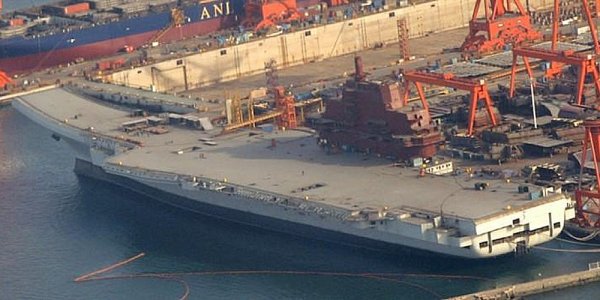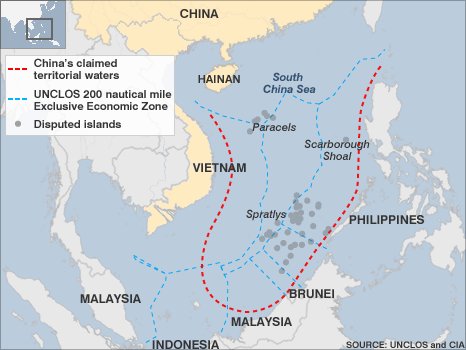Strategy Page has the details:
Recent photos from a Chinese shipyard appear to show a section of a new Chinese aircraft carrier under construction. This appears to be a carrier similar to the American Nimitz class ships (100,000 ton vessels using a catapult rather than a ski jump flight deck for launching aircraft). Large ships, including warships, are often built in sections than the sections are welded and bolted together. The section of what appears to be a carrier does not indicate the exact size of the new carrier other than that it appears larger than the new carrier China commissioned at the end of 2012.
Last September China commissioned its first aircraft carrier, the Liaoning. At the time China was believed to be building the first of several locally designed aircraft carriers but the Chinese officially denied this. The only official announcements have alluded to the need for two or three aircraft carriers, in addition to the Liaoning. Construction of such large ships had not yet been seen in any shipyard. That has changed with the appearance of these new shipyard pictures.
[…]
The new Chinese “larger carrier” apparently means something like the recently decommissioned American USS Enterprise (CVN 65). This was the first nuclear powered carrier and it served as the prototype for the subsequent Nimitz class. It’s unclear if the new Chinese carrier will be nuclear powered. The Enterprise was an expensive design, and only one was built (instead of a class of six). While a bit longer than the later Nimitz class, it was lighter (92,000 tons displacement, versus 100,000 tons). The Enterprise was commissioned in 1961, almost 40 years after the first U.S. carrier (the Langley) entered service in 1923. In the two decades after the Langley there were tremendous changes in carrier aviation. While the innovation slowed after World War II, major changes continued into the 1950s (jet aircraft, nuclear propelled carriers, SAMs). But in the ensuing half century there has been no major innovation in basic carrier design. This has not been a problem because the carriers have proven useful, at least for the U.S. Navy (the only fleet to use such large carriers) and no one else has maintained a force of these large carriers. Only the U.S. has felt a constant need to get air power to any corner of the planet in a hurry. More importantly, no navy has been able to give battle to the U.S. carrier force since 1945. The Soviets built new anti-carrier weapons and made plans to use them but that war never occurred. China is building carriers but is not committed to having a lot of them to confront the U.S. but to intimidate its neighbors.
BBC News has a series of photos of the Liaoning from purchase to commissioning:

Click to see full-size images at the BBC website
Earlier reports on the progress of the Liaoning (under the name Shi Lang) can be found here.
Update: James R. Holmes on why China might be interested in becoming a 21st century naval power.
A couple of years back, when Beijing made its aircraft-carrier aspirations official, the fine folks at Foreign Policy asked me to explain why a historic land power like China cared about flattops. Being a bear of small brain, I reached into my mental bag of tricks and came up with Thucydides’ claim that fear, honor, and interest are three of the prime movers for human actions. Beijing feared U.S. containment, a relic of the Cold War; saw an opportunity to recoup honor lost during the century of humiliation at the hands of the imperial powers; and hoped to add to the naval power it was amassing to advance China’s interests in maritime Asia.
What’s changed since then? Fear and honor are emotional needs. It may be that sending the carrier Liaoning (formerly the Soviet Varyag) to sea helped satisfy China’s need to banish bad cultural memories. But who knows when fear will be at bay? The United States and its allies have ruled the sea in East Asia long enough that their navies may inspire fears disproportionate to their actual margin of supremacy. Or, the Chinese leadership may see value in protesting too loudly, and thus making Western powers fearful of creating a self-fulfilling prophecy, namely Sino-American antagonism.
Most importantly, it may be that having ameliorated anxieties arising from honor and fear grants Beijing the luxury of operating mostly from calculations of interest. Simply deploying a carrier, Liaoning, may forestall fears while satisfying Chinese society’s desire for a capability that every other great power enjoys.






